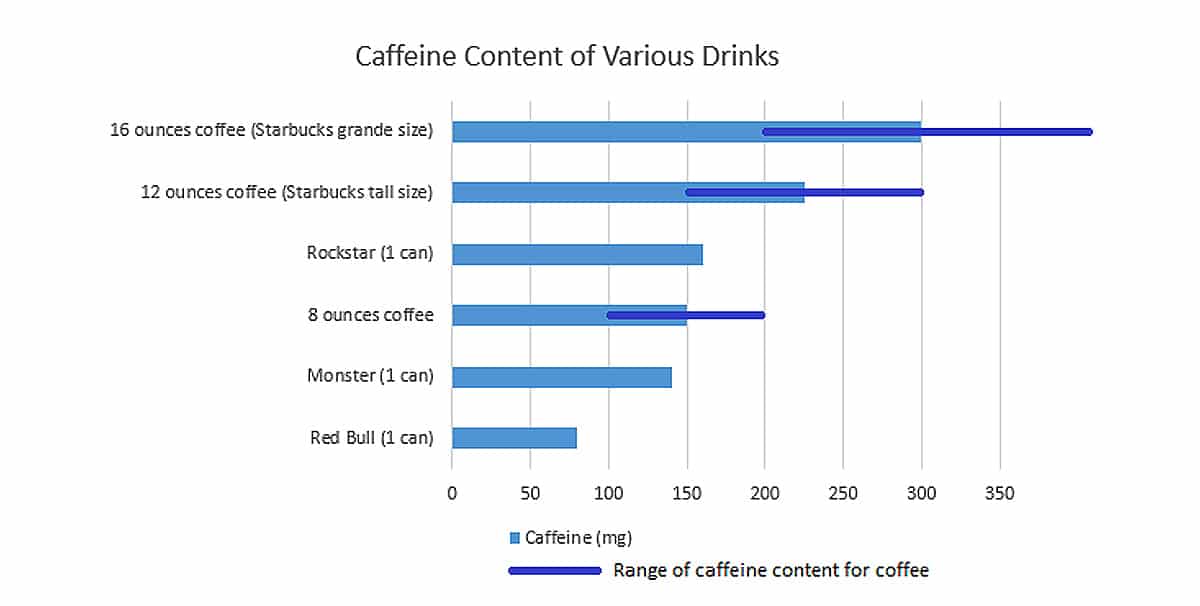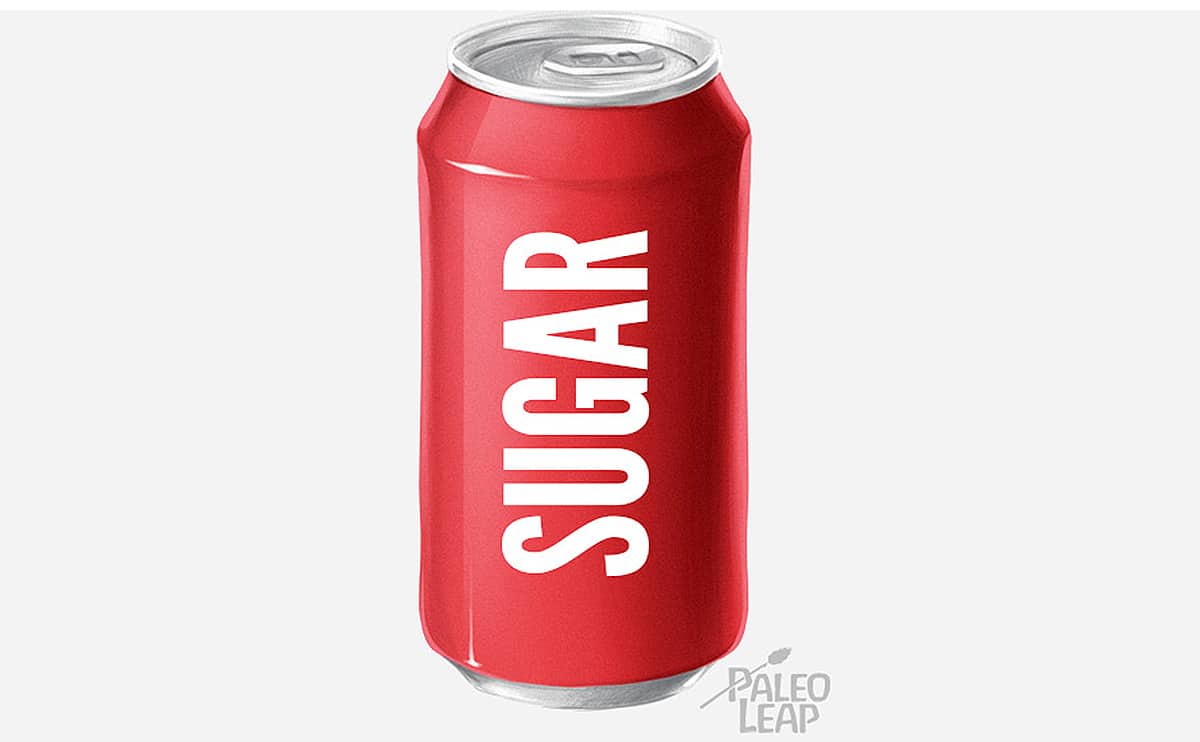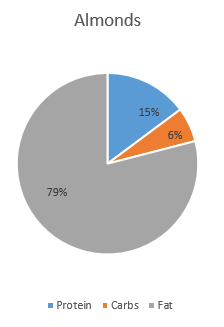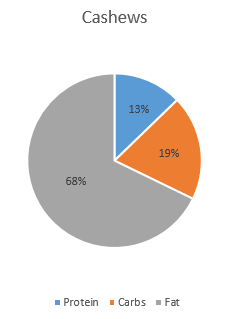Energy drinks have been in the news lately, and none of the press has been good. Mostly, the criticism is about how much caffeine they contain, and especially how they’re marketed to kids and teenagers who want to look cool, encouraging younger and younger kids to drink extreme amounts of caffeine.
If you ask most people to compare Red Bull to coffee without letting them read the labels, most people would probably say that Red Bull has a lot more caffeine. It’s just a gut instinct that these weird energy drinks have giant doses of caffeine. They’re always in the news for it! It feels so logical you almost don’t have to think about it. But actually…

8 ounces of coffee contain between 100 and 200 milligrams of caffeine. The smallest size at Starbucks is 12 ounces (150-300mg caffeine), and a typical coffee mug is 16 ounces (200-400mg caffeine). 1 can of Monster energy drink has 140 milligrams of caffeine. 1 can of Rockstar has 160. 1 can of Red Bull has 80.
Compared to coffee, energy drinks have a comparable or lower amount of caffeine. The gut instinct telling most people that they must have an extreme caffeine content isn't based in reality. It's a product of marketing (neon colors, branding that looks extreme, names like Monster) and your brain taking shortcuts based on media hype.
That’s the problem with gut instincts: we make a lot of decisions based on them every day because they feel logical and obviously right, but sometimes they’re wrong. The same thing applies to the gut instincts we use to make decisions about food. Sometimes, they're very useful - your gut instincts will tell you to pick a salad over a double cheeseburger, and (in most cases) your gut instincts will be right. But sometimes, they're wrong.
Here are 5 common gut instincts about food that simply aren’t backed up by actual scientific evidence.
1. High-Fructose Corn Syrup is Different From/Worse Than Sugar

Actually, they’re chemically almost identical. Sugar has 50% fructose and 50% glucose. High-fructose corn syrup has 42-55% fructose and the rest glucose. Fructose in large quantities is bad for you, but high-fructose corn syrup doesn't have significantly more fructose than ordinary sugar. The vast majority of studies have failed to find any significant difference between the two in terms of human (or rat, for that matter) health.
High-fructose corn syrup isn’t unhealthy because it’s worse than sugar. It’s unhealthy because it is sugar – and because it’s usually found in forms that encourage overeating it (like soft drinks). A healthy diet will be low high-fructose corn syrup just like every other form of sugar, because sugar is bad enough all on its own. Overeating any kind of sugar is dangerous. Focusing on high-fructose corn syrup as somehow especially dangerous or bad just takes the pressure off sugar in general, and lets soft drink companies trick people into thinking that "naturally sweetened" soda is somehow healthier than regular soda (it's not, because it's all sugar).
2. Nuts are High in Protein
Vegetarians love to describe nuts as a protein source – and it’s true that nuts have some protein in them. But when you really break it down, the majority of calories in most nuts come from fat, not protein:
A typical Paleo meal should involve around 30 grams of protein (there are exceptions, but that's the out-of-the-box protein range that works well for most people). A handful of nuts typically contains around 4-6 grams of protein. Nuts are simply not a good protein source.
3. Funding From Sugar/Soft Drink/Junk Food Companies is Skewing Research.
In one sense, that’s true. Coke in particular is a master at this, from sponsoring dieticians’ conferences to sponsoring research that frames physical inactivity (rather than…eating huge amounts of sugar) as the real problem with obesity.
It’s true that funding from sugar and junk food interests is affecting research. The myth is that sugar and junk food interests are the only ones. Consider…
Effects of egg consumption on carotenoid absorption from co-consumed, raw vegetables (American Journal of Clinical Nutrition, 2015)
- Industry sponsor: the American Egg Board-Egg Nutrition Center.
- Conclusion: “co-consuming cooked whole eggs is an effective way to enhance carotenoid absorption from other carotenoid-rich foods such as a raw mixed-vegetable salad.” (Translation: eggs make your salad more nutritious)
Inclusion of red meat in healthful dietary patterns (Meat Science, 2014)
- Industry sponsor: the author is associated with the National Cattlemen's Beef Association, and a contractor to the Beef Checkoff Program.
- Conclusion: “Several studies have shown that lean red meat can be successfully included in recommended heart-healthy dietary patterns without detriment to blood lipids. Furthermore, increased dietary protein has been shown to promote healthy body weight and composition, in part by increasing satiety, and to improve vitality and stamina.”
Supplementation with eicosapentaenoic acid-rich fish oil improves exercise economy and reduces perceived exertion during submaximal steady-state exercise in normal healthy untrained men. (Bioscience, Biotechnology, and Biochemistry, 2014)
- Industry sponsor: one of the authors is a current employee of a company that makes fish oil supplements for athletes; another is a former employee.
- Conclusion: “Supplementation with fish oil for 8 weeks improved exercise economy and reduced perceived exertion during exercise in normal healthy untrained men.”
Paleo-friendly studies do this too. Bad science isn’t limited to one side of the debate. There’s a powerful meat and egg lobby just like there’s a powerful sugar lobby, and both sides are trying to skew the data in their own favor.
It’s hypocritical to blindly accept studies from industry sponsors we agree with while criticizing studies from everyone else. Either industry funding is wrong, or it’s acceptable, but it can’t be wrong when we don’t like the results and perfectly fine when we do.
4. White Potatoes are Not Nutritious.
Yes, they are. Usually the statement that white potatoes aren't nutritious comes along with a comparison to sweet potatoes, with sweet potatoes appearing as the nutrient-dense alternative. Here’s a chart comparing 100 grams of raw sweet potato to 100 grams of raw white potato:
*Technically, this is in the form of pro-Vitamin A, which your body has to convert to actual Vitamin A. The conversion is pretty inefficient, so overall you'd be getting less than 284% of your daily needs.
Sweet potatoes and white potatoes have different nutrients, as you would expect from two completely different foods. But sweet potatoes are not nutritionally flawless angels, and white potatoes are not nutritionally bankrupt junk food, and on the whole, they’re roughly equally nutritious, just in different ways.
If you’re concerned about the glycemic index, the types of carbs found in each, or the autoimmune protocol, here’s an explanation of how those things matter in real life.
5. “Lean Protein” is Best.
Even in the Paleo world, a lot of people love to tout the virtues of “lean protein,” by which they mean protein without much fat attached (like chicken breast and tuna). It’s basically a euphemism that the diet industry dreamed up to mean “low-calorie animal foods without all that artery-clogging saturated fat.”
The only problem with this is that saturated fat doesn’t actually clog arteries, and fat is an essential nutrient. If you only eat lean protein, you’re depriving your body of a crucial source of fuel.
There’s nothing wrong with chicken breast or tuna, provided your meal also includes another source of fat (e.g. an avocado). But there’s also nothing extra-special about it. Paleo is all about not being afraid of animal fat! The skin on a chicken breast or the marbling on a nice piece of steak is a natural source of fat that occurs as part of a whole food; it’s not something to be afraid of. There’s no need to go crazy over “lean protein.”
Have you ever had a gut instinct that got challenged by a new piece of research or information? What was it? Let us know on Facebook or Twitter!








Leave a Reply